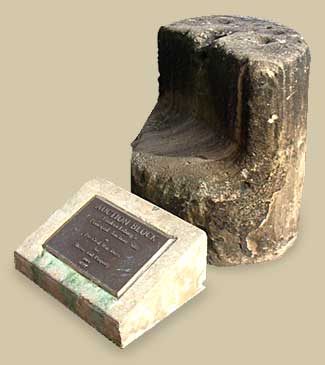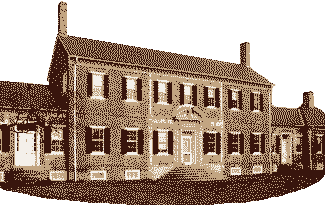Letters to Doctor James Carmichael & Son
Historical Collections at the Claude Moore Health Sciences Library, University of Virginia
IMPORTANT: Please upgrade your browser to view this site as intended.
Site Navigation
Path to Current Page

- Auction block: Fredericksburg’s principal auction site in pre-Civil Way days for slaves and property.
In the letters written by slave owners to the Carmichaels, there are nearly 100 references to sick or injured slaves.
The slave community in the Fredericksburg area faced serious, painful ailments on a regular basis. Although the enslaved blacks are not the authors of these letters, it is possible to learn at second-hand about their pain and discomfort through their owners or overseers. William Jackson Jr. informed Carmichael that a small eight-year-old girl has a “violent pain in the head.”[see letter] Burwell Leavell wrote of a slave man who was in “considerable pain” and “cannot Rest well.”[see letter] Jane Mitchell described her “servant girl” as having an ulcerated leg and complaining of a “most excrutiating[sic] pain” and being in “great distress.” [see letter]
While both white and black communities in the South faced illness, some of the diseases experienced within the slave community resulted from the racially oppressive system of slavery. Because southern society considered slaves to be chattel, slaves often lived and labored in unhealthy environments. While conditions varied from one plantation to another, in many cases overwork, lack of proper nutrition, and unsanitary living conditions directly contributed to their susceptibility to disease and the spread of disease.1 Unsanitary living conditions led to many of the ailments mentioned in the slave owner correspondence to the Carmichaels. In his case study of Virginia, historian Todd Savitt estimates that waste removal occurred only once a year on average.2 Decaying food scraps and human waste were breeding grounds for mosquitoes and flies. Mosquitoes transmitted yellow fever or malarial parasites to humans. It is quite possible that many of Carmichaels’ patients complaining of the “ague & fever” were really suffering from malaria.
The frequent presence of human excrement in the drinking water also led to epidemics of cholera, dysentery, diarrhea, typhoid, and hepatitis. Additionally, sewage caused the proliferation of parasitic worms that could be found in the lungs, liver, blood vessels, gall bladder, and intestines.3 Savitt writes that slave children were particularly susceptible to worms. He explains, “children playing in the dirt inevitably picked up worm larvae as they put fingers in their mouths. Failure to use, or lack of, privy facilities only served to spread worm disease to other residents of the quarters and to visiting slaves, who then carried these parasites to their own plantation quarters.”4 Worms are frequently mentioned in the Carmichael letters, particularly in regards to illness in slave children. For example, George Banks desired a prescription from the Carmichaels for an eighteen-month-old slave child. He wrote, “it has a disentry[sic] for 3 or 4 weeks proceding[sic], we think from worms—in this time it has discarded more than 20 worms principally from the stomach…”. [see letter]
Masters and mistresses performed a variety of health care needs for their slaves prior to summoning a physician. Southern families often possessed their own medicine chest filled with popular remedies of bleeding, vomiting, and purging. In November 1827 Charles R. Battaile wrote, “I have a very sick woman who was taken a few days since, with fever, pain in the head, and slight delirium, but constant pain since she was taken: it commenced with an ague. She complained also of a sore throat but that is not very evident. I bled her for cold, Gave her a dose of Calomel and castor oil, also blistered but without any abatement as yet of symptoms.” [see letter] Caring for the ill slaves and dispensing medicine was also an important role for women on the plantation. For example, Isabella Herndon, the family “doctriss” [see letter & see letter], gave cathartics, teas, oils, salts, and calomel to various sick slaves. She even made suggestions about courses of treatment in the letters to the Carmichaels. The correspondence of Elizabeth Withers, another plantation mistress, also shows that she took an active role in being a caregiver to her family’s slaves. She wrote the Carmichaels informing them of a boy who had lockjaw. She gave him salts, and bled and blistered the child, but to “no avail.” [see letter]

- Chatham Estate: M Jones of Chatham instructs Dr. Carmichael, “I am informed a Woman belonging to the estate lies very ill – I will thank you to ride as far as the Cabins beyond the overseers house & see her – after doing please call by the House…”
If the home remedies did not yield positive results, the Carmichael letters demonstrate that slaveholders either sent their slaves to the Carmichael office with notes explaining their complaints or summoned physicians to their plantations to treat their ill slaves. Slave owners often wrote the Carmichaels for the most urgent needs. A slave woman facing complications during labor was one of the more common reasons to obtain the Carmichael’s services. In 1824 Thomas Seddon wrote, “I have a Negroe Woman on my Plantation in Labour She Requires your aid. Will you Ride out this morning & See her If you cannot go yourself send Edward. I Just Recd a note from my overseer who Says it is an Urgent Perhaps a Calcutta Case.” [see letter] The Carmichaels treated male slaves for ailments that the slaveholder worried would affect the slave’s ability to work. F. S. Stoel sent his slave Israel to the Carmichaels pleading for medicine to cure him quickly as Israel was his “best hand to the Plow and I am about to seed Wheat, and am now loosing by his improvidence.” [see letter] John Clark, possibly overseeing slaves hired to work on constructing the Chatham bridge, wrote the Carmichaels about examining Ned, a slave whose fingers were dangerously frostbitten. Clark hoped Ned could be cured without amputating his fingers because “his work upon the bridge is a considerable loss.” [see letter]
Providing health care for slaves constituted the signifcant part of the medical practice of the Carmichaels during the antebellum years. Emancipation and the depletion of the area planters’ wealth following the Civil War directly affected the medical practice of the sons of James Carmichael. A letter written by the wife of George French Carmichael in 1866 states, “Before the war, he [Dr. Carmichael] had been employed on the large estates in the neighborhood where so many slaves were owned, making it very profitable. Now, of course, that is lost, and the fortunes of his other patrons are so reduced they never call in a physician unless compelled.”5
Footnotes
- For discussions on health of slaves see Leslie Howard Owens, This Species of Property: Slave Life and Culture in the Old South (New York: Oxford University Press, 1976), William Dosite Postell, The Health of Slaves on Southern Plantations (Baton Rouge: Louisiana State University Press, 1951), Todd Savitt, Medicine and Slavery: The Disease and Health Care of Blacks in Antebellum Virginia (Urbana: University of Illinois Press, 1978), Kenneth F. Kiple and Virginia Himmelsteib King, Another Dimension to the Black Diaspora: Diet, Disease, and Racism (Cambridge: Cambridge University Press, 1981), Nancy Krieger, “Shades of Difference: Theoretical Underpinnings of the Medical Controversy on Black/White Difference in the United States, 1830-1870, ” International Journal of Health Sciences 17 (1987): 259-278, and Nancy Krieger and Mary Basset, “The Health of Black Folk: Disease, Class, and Ideology in Science,” Monthly Review: An Independent Socialist Magazine 38 (July-Aug 1986): 74-85.
- Savitt, Todd. Medicine and Slavery: The Disease and Health Care of Blacks in Antebellum Virginia (Urbana: University of Illinois Press, 1978), 60.
- Savitt, p. 57-73.
- Todd Savitt, “Black Health on the Plantation: Master, Slaves, and Physicians, ” in Sickness and Health in America (Madison: University of Wisconsin Press, 1985), 324.
- Blanton Wyndham Bolling, Medicine in Virginia in the Nineteenth Century, (Richmond: Garrett & Massie Inc., 1933), 362.
© 2019, Rector and Visitors of the University of Virginia
Historical Collections and Services at the Claude Moore Health Sciences Library